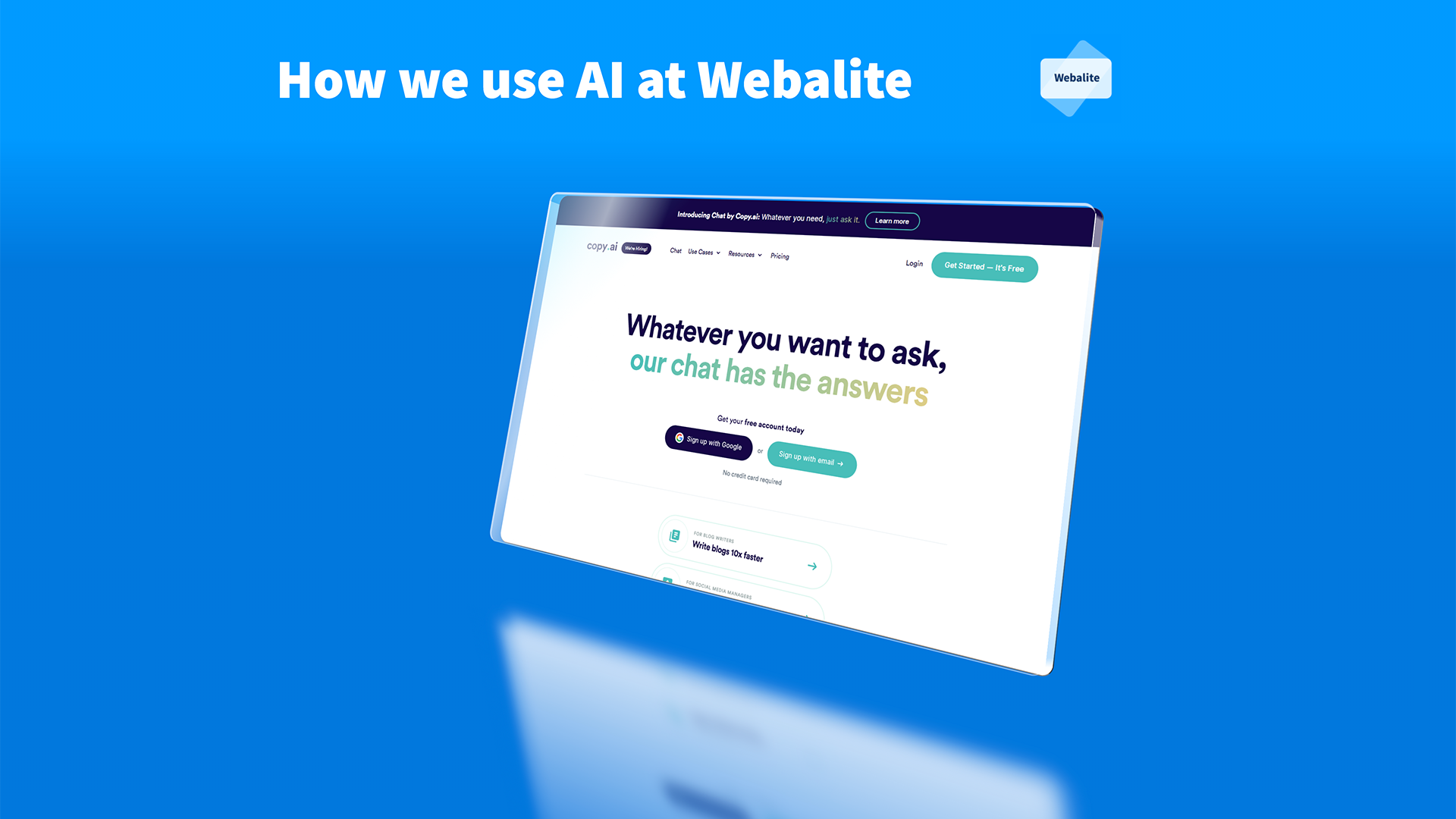How we’ve been using AI at Webalite
Last week I went to an inspiring talk about AI (artificial intelligence). It was a refreshing change, this was a talk by someone techy who knew what they were talking about, with actionable applications. The talk inspired me to implement an AI Policy for Webalite and create this post.
Most of us have been [unknowingly] using some type of AI for years, and almost all of us have had AI used on us.
Predictive text in our email, voice assistants like Siri, Alexa, or Google Assistant and Maps Apps rerouting us to save time on our journey. Social media algorithms decide what we see, and shopping sites and advertising have been using AI on us for years too. Recently, my partner was shopping with a friend for a wedding dress and while they were shopping I was served ads, on my mobile phone, for wedding suits (if you ever think it’s a coincidence, it’s not).

Here are some of the ways we’ve been using AI at Webalite:
Voice reminders with Siri
I often ask Apple’s virtual assistant Siri to “remind me when I get to Moore Wilsons to buy coffee beans”. Siri (usually) figures out what to remind me about and knows where I shop so I get a reminder in the right place at the right time. However, Siri sometimes fumbles names and instructions meaning I have no idea what the reminder is for.
In my experience, Google Assistant is much better at accuracy and voice recognition, but I have an iPhone, so I use Siri.
Autocomplete in Gmail
Even as I write this, Google Doc is helping me write “gooder english”. Autocomplete is more advanced in Gmail and it creates predictive lines of text, making it easy to complete sentences by hitting tab. Learning from my historic email greetings, it knows who to greet formally, or more casually. And, for me, it’s helped me avoid embarrassing mistakes by spelling people's names correctly.
Music recommendations in Tidal
I can’t work without music. But, I prefer to listen to albums so most of the time I have Tidal’s 'pick my next track' feature turned off. But, it still makes recommendations for other albums based on what I like to listen to. Spotify has a much better algorithm than Tidal but I prefer the sound quality of Tidal.
Ad placement and targeting with Google Adwords and Facebook
Unfortunately, AI has taken over ad placement and targeting which has reduced our ability to place an ad when and where we want it. In a small market like New Zealand we often want to target small groups of people – too small for AI to make sensible predictions about in a short time frame. Some ad types are placed in random places a human would never place an ad which is open for manipulation by people gaming the system with ad clicks.
Because people manipulated the system (and the tech companies finally reacted) privacy has increased and we will have to rely more and more on AI in the future.
Video transcription for SEO and subtitles
Creating video transcripts is a slow and tedious job. With Otter.ai you can upload a video, or sync it from inside Adobe Premiere, and you will receive a transcript of the video for SEO or subtitles on the video.
The first time I uploaded a video I had to correct the spelling of my last name (because of the kiwi accent) and my company name (because I made up the word). The next video transcribed perfectly with the correct names because the system learnt how to spell Eastwood and Webalite, despite my accent.
Meeting transcripts using Fathom.video
After trying several meeting transcription services we decided to go with Fathom.video because it allows us to bookmark a task, which it summarises, and pushes into our HubSpot CRM, linked to the other person in the meeting.
There are now several amazing tools, all with pros and cons, so it’s really about choosing the one that works for you. If you're looking for something simple but effective for your business meetings, this might be what you need!
Research with ChatSpot
While it’s been inspiring seeing how AI can generate content from the internet, the big shift for me is AI connected to APIs. An API (Application Programmers Interface) is how geeks like me connect systems together to securely pass information back and forth. Connecting AI to an API suddenly gives us the ability to analyse our data and use AI to report on complex results.
ChatSpot is how HubSpot has connected ChatGPT 4 with the HubSpot API to allow us to analyse the data in our CRM as well as all the other functionality that comes with ChatGPT. The team at HubSpot has strict guardrails on what and how the AI uses the data and as new features are added, some are removed out of an abundance of caution.
So far the results have been interesting, but not a game changer… yet.
Image generation
There are several 'text to image' generation tools using AI. While these are fun and interesting, they aren’t useful for me because I have very specific ideas in my mind which I like to develop.
These tools allow users to upload an image and then type out what they want it to look like, or vice versa, with varying levels of success depending on how much information is provided by the user.
Recently I tested the AI by creating a logo for one of our clients. No matter how much I changed the prompts it still came back with minor variations of a boring logo. Since then, I’ve tried some of the AI generators specifically for logo design but the results have been very disappointing.
Content creation with copy.ai
I hate writing policies and contracts. To write the AI Policy for Webalite I wrote a few prompts before I asked Open AI's ChatGPT, via copy.ai, to:
> Write a legal AI Policy for our website explaining how we use AI for content generation, writing code and improving productivity
I asked for another bullet point about copyright:
> add section on copyright
And added a specific point about our use of notetakers:
> add a bullet point for our ai policy about how we use ai notetakers
With a little bit of editing I had a first draft, Grace then edited to improve the language and it was published. Easy.
Writing this article I tried the Blog Outline Tool in copy.ai – which is an amazing tool if you don’t know what to write. In this case I knew what I wanted to say and the tool actually got in the way. I let the AI use some of its ideas so it didn’t feel bad, but I discarded all of the content and went back to writing what I wanted to say.
Writing Adwords headlines and descriptions for websites has been helpful, it’s almost like having someone else to brainstorm with. Google Search Consoles suggested content has been embarrassingly bad.
Pair programming with Git Copilot
I am a self taught coder who spends way more time reading Stack Overflow, to figure out why my code isn’t working and Googling the correct syntax as I switch between languages, than I do writing code. I probably spend more time swearing than writing code.
Git Copilot is a game changer.
I installed a trial to see how it worked and got some spectacular results immediately.
When I dipped into projects to fix a bug or add a feature I was shocked at the accuracy of the autocomplete. Then, I experimented with writing instructions and Git Copilot writing whole blocks of code.
People talk about the eerie way AI seems to know what you think before you think it, this was how I felt with Git Copilot, it was not only completing my sentences but it was already writing the next line of code before I’d finished reading what it wrote.
But, it’s not as simple as jumping in and writing code.
I’ve spent decades swearing at the screen, learning from my mistakes and I’ve had some amazing team members who have taught me a lot. Git Copilot makes stuff up - the same way ChatGPT makes stuff up - known as hallucinations. I’ve had Git Copilot compose lines of code that fit perfectly into my project, as if I’d written the code myself, but they referenced code which doesn’t exist and so the code would fail.
Things to look out for when using AI
AI is still emerging and there are issues. Here’s a few things to be wary of when using AI.
AI makes stuff up
Just like humans, AI makes stuff up and replies confidently because it found an answer. The answer can be misleading, out of context, or false. Always check the source of the information to ensure it’s correct.
AI has biases
Similar to humans, unfortunately, AI learns sexism and racism because its source is the internet which is loaded with inequality. Always ensure you check for equality and diversity. Never let AI automatically publish content without proof reading it first.
Lack of citations and named sources
AI content generators are only just starting to include citations that allow us to verify the information and credit sources. If you don’t check sources you risk publishing misinformation propagated by bad actors.
Copyright
Some AI Content Generators, like Adobe, are addressing copyright issues by only using source material where they own the copyright. While we’re big fans of Creative Commons we respect other people’s copyright.
Privacy
Ensure there are clear guardrails for how data is processed and stored. If in doubt, don’t upload your data. Never share any data that has private or confidential information.
How are you using AI?
Please leave a comment below to share with us how you are using AI in your day to day life.
The future of AI
There are many challenges that we need to overcome with AI to make it safe, secure, and fair. Privacy, copyright, and ethics need to be addressed before AI takes a bigger role in society.
For now, I’m excited to use tools to increase my productivity and reduce the mundane tasks so I can spend more time on the tasks that require a human touch.
—
This article was drafted by humans, assisted by AI, edited by humans and proofed by humans.


